Museum Temporarily Closed (January 2024)
The museum will be closed for collection care in January and February.
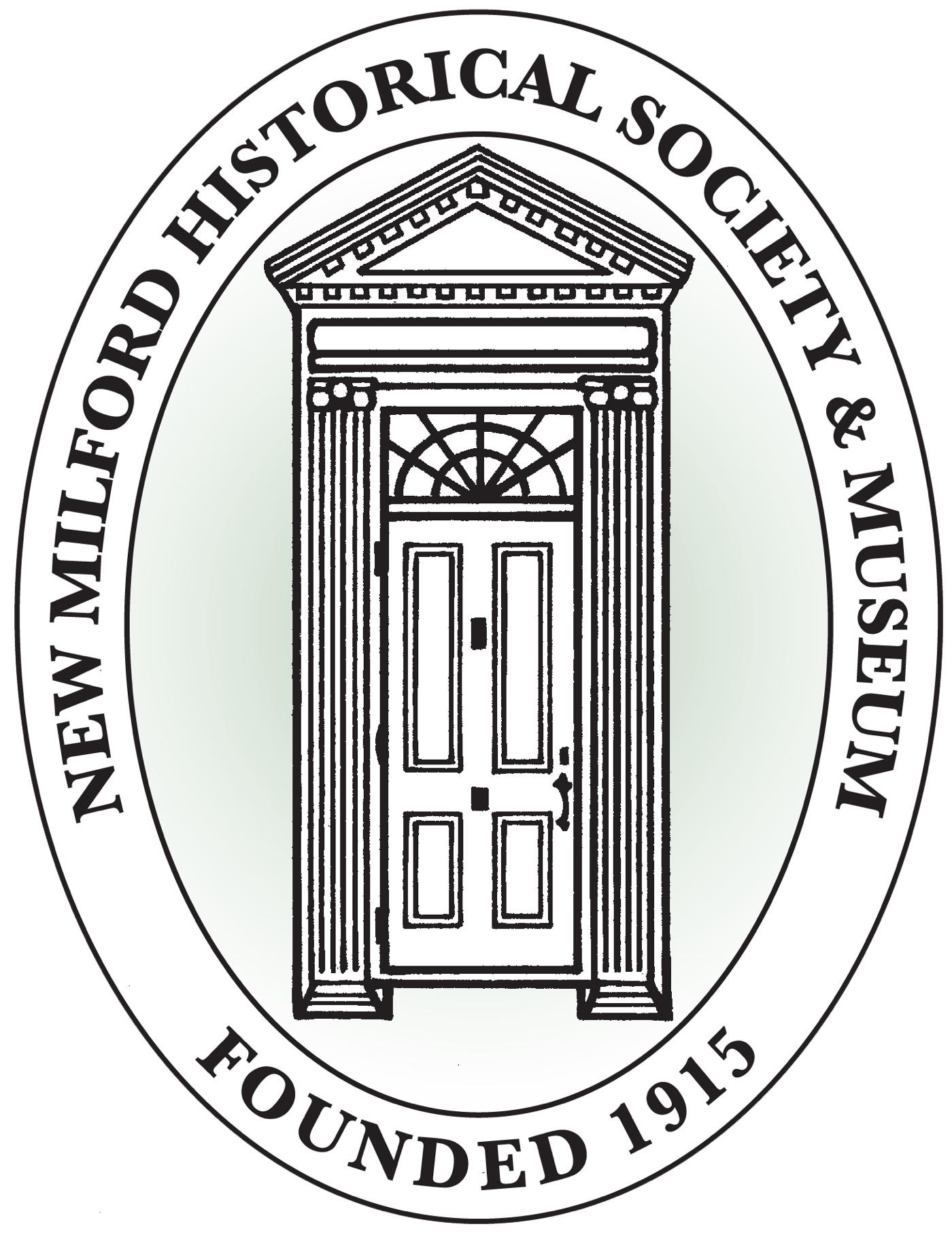
Call or email with research or other requests:
860 354 3069

nmhistorical@gmail.com

Call or email with research or other requests:
860 354 3069

nmhistorical@gmail.com

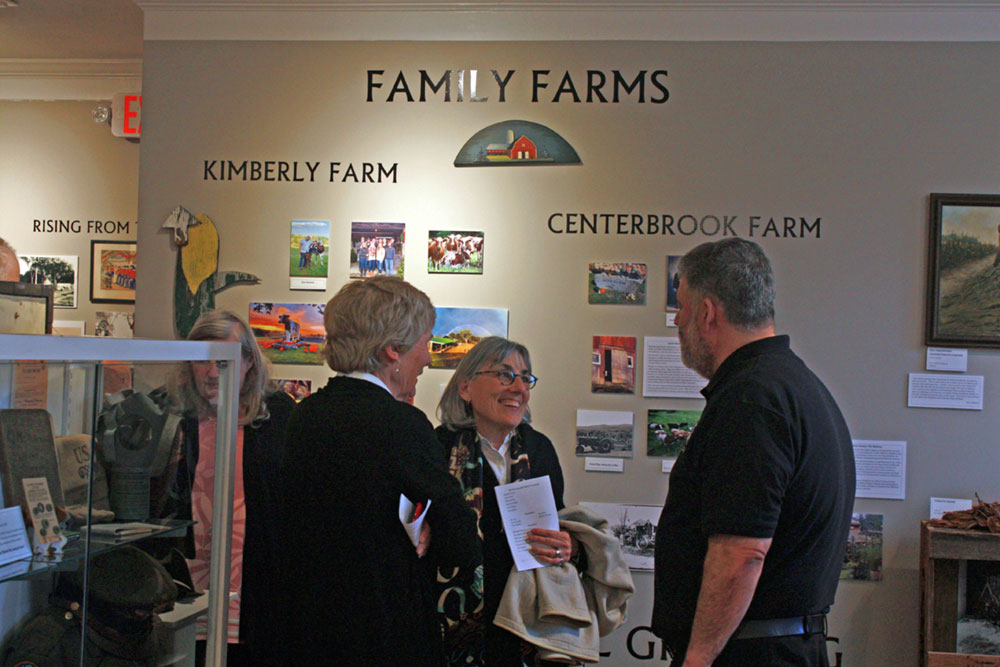

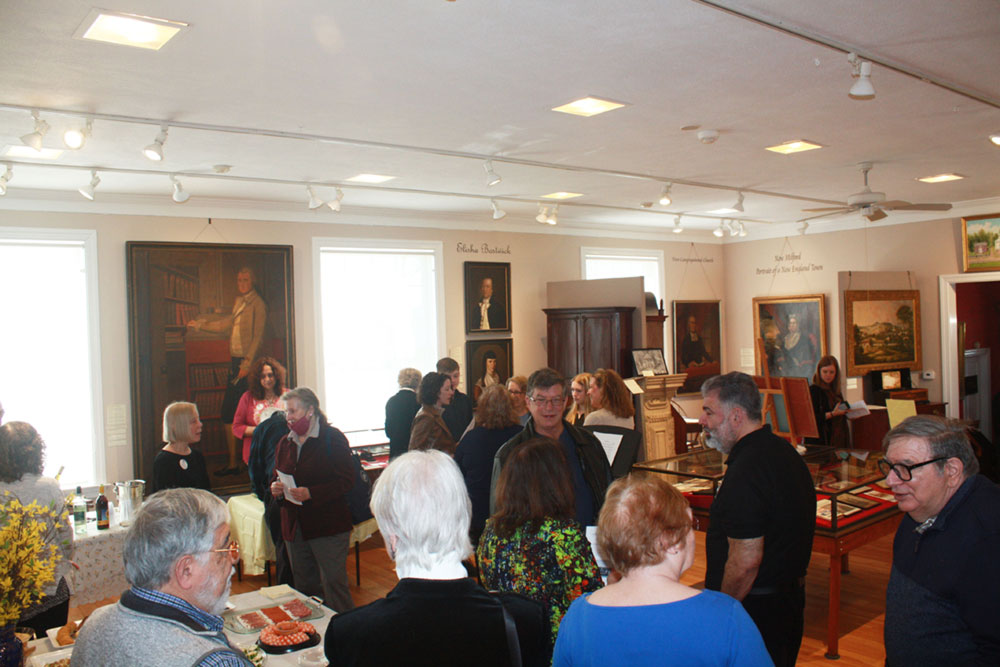
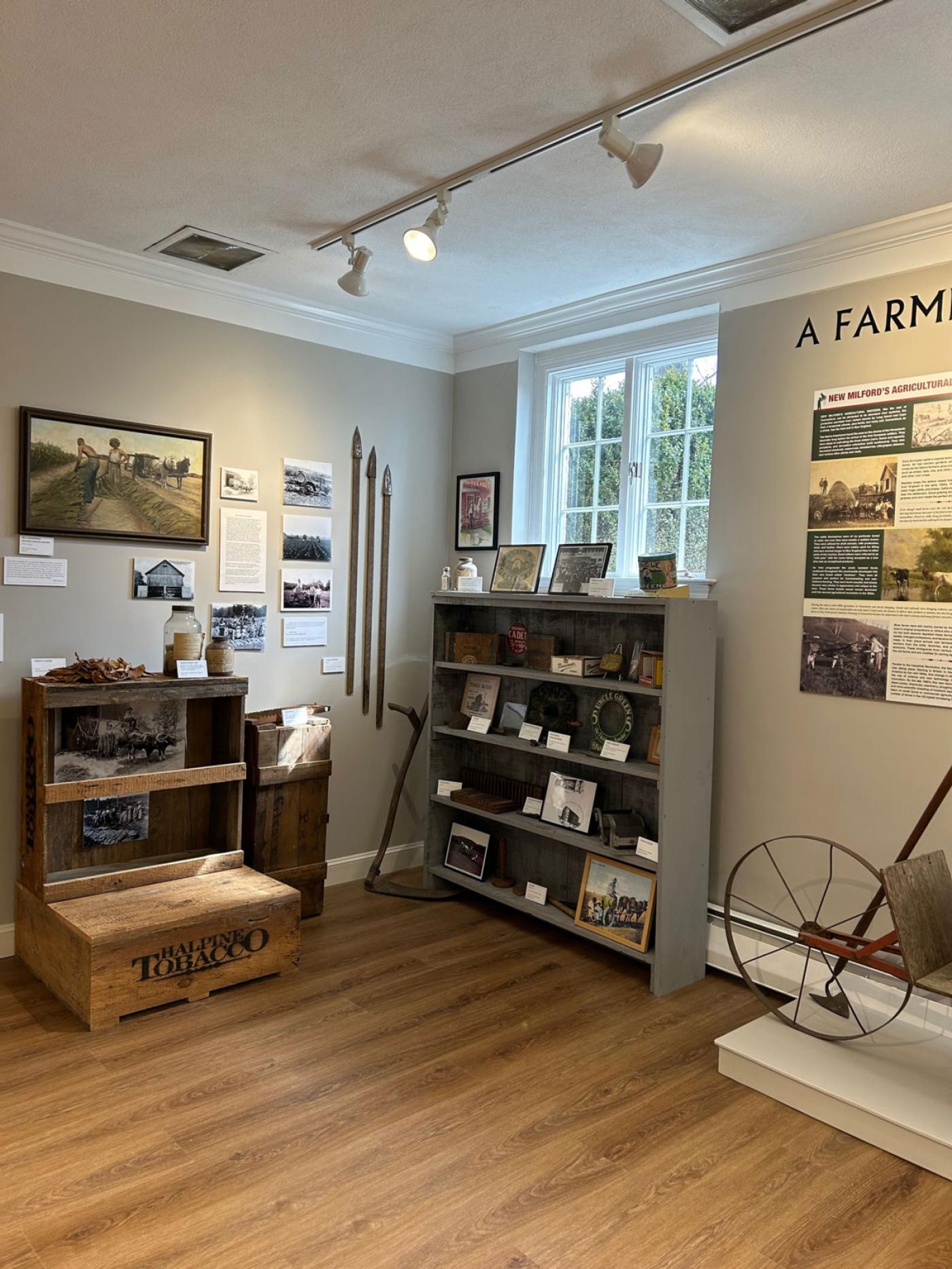
 Showcased are the Indigenous People who lived and worked the land, the development of our agricultural roots, the establishment of the railroad, and on through early businesses, trades, and industries.
Showcased are the Indigenous People who lived and worked the land, the development of our agricultural roots, the establishment of the railroad, and on through early businesses, trades, and industries.
The exhibit space is filled with impressive pictures and artifacts, brought out of storage after many years.
View military uniforms, medals, and memorabilia belonging to our hometown heroes; experience, through stunning images the resiliency of 1902 residents as they rebuilt after the Great Fire of 1902; understand the presence and importance of farming on our land; meet influential people and faces of old New Milford; discover the evolution of business and tourism when the train came to town; window shop through fancy goods, hat boutiques, and hardware stores; acknowledge and respect the industrious indigenous people who were here ï¬rst.
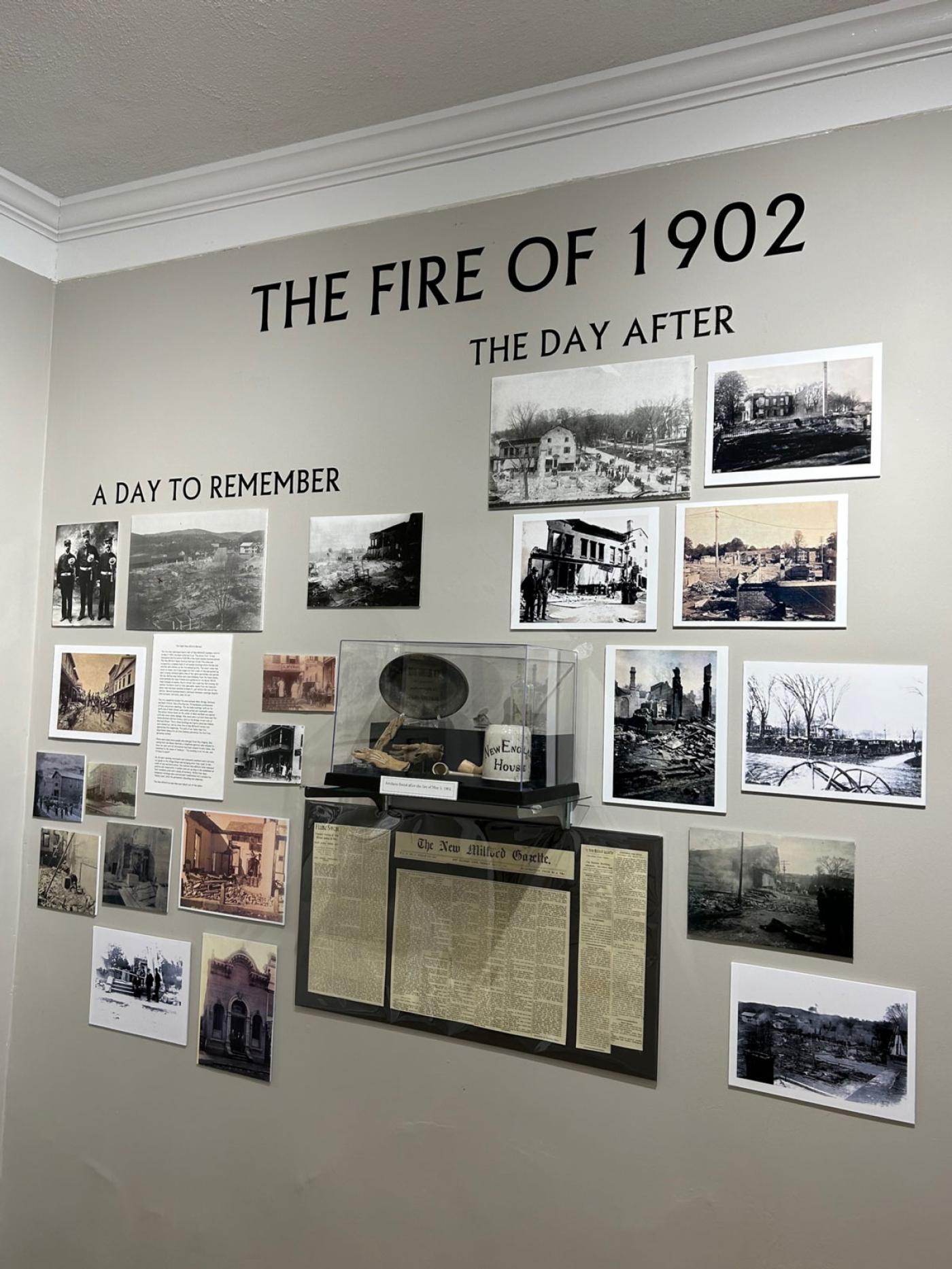 Special features include The Great Fire of 1902, farms still operating today, military memorabilia, and intriguing New Milford characters.
Special features include The Great Fire of 1902, farms still operating today, military memorabilia, and intriguing New Milford characters.
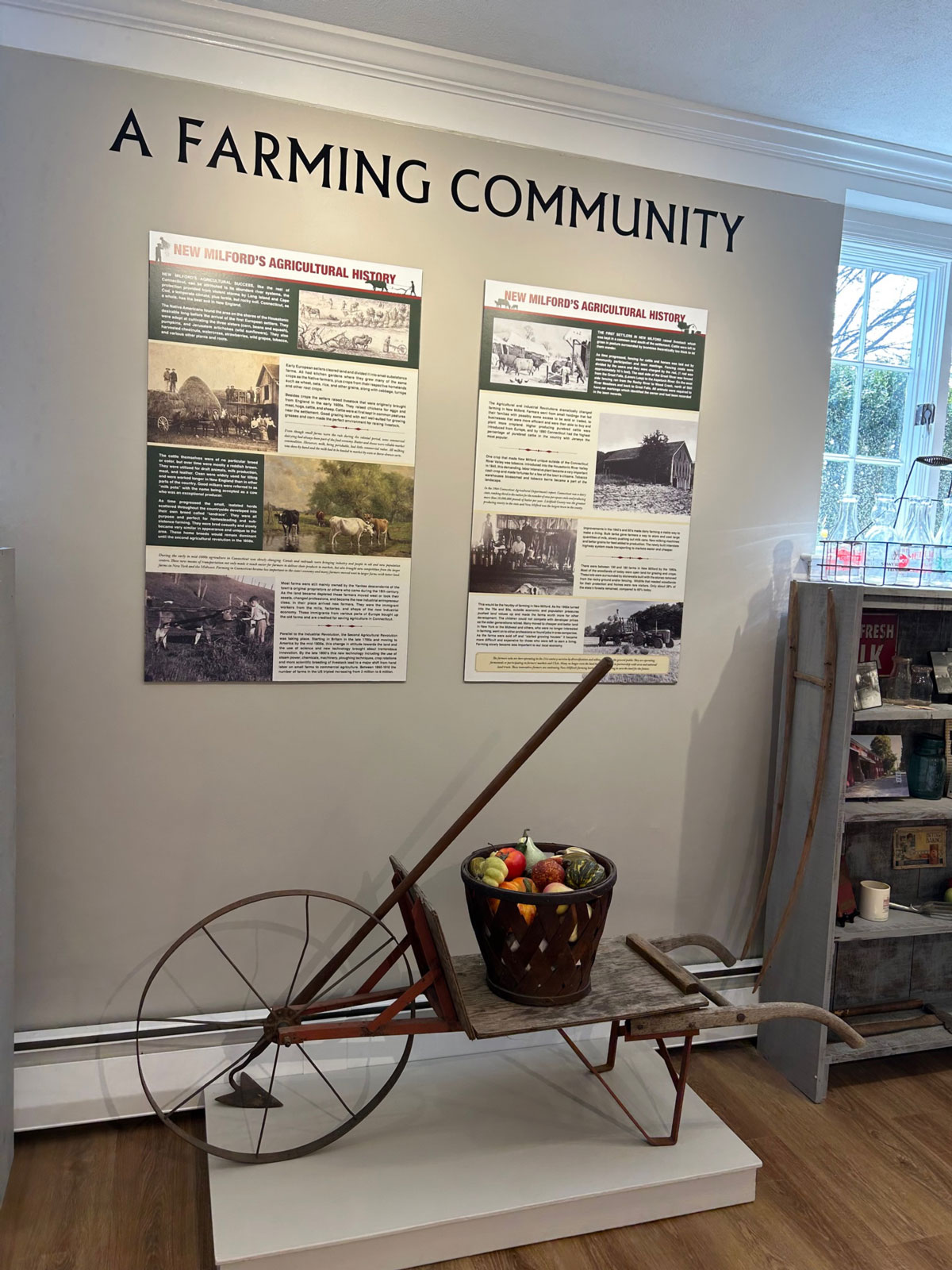 The exhibits have been mounted with respect, extensive research, and a passion to preserve the history of this beautiful town.
The exhibits have been mounted with respect, extensive research, and a passion to preserve the history of this beautiful town.
Become immersed in a very unique and memorable experience as you are transported in time to the beginnings of our treasured town.
On December 12, 2021, our museum was ï¬lled with music, fellowship, and pride as we unveiled our Black Experience in New Milford Exhibit. This was the culmination of a year-long journey embarked upon by our curator and a committee of trustees, community members, and descendants of honored Black New Milford families.

This was a true community effort with Underground Railroad quilt squares crafted by the the Senior Center quilters, research assistance by the Congregational Church staff, oral histories ï¬lmed and edited by the Youth Agency Media Production staff, and display panel creation and assistance through Katart Graphics, a local graphic design studio. We are grateful for these partnerships.
This is a permanent exhibit, that chronicles the history of Blacks in the United States from the time of slavery, through the Revolutionary and World Wars, and the journey from Reconstruction to the Great Migration and the Civil Rights Movement. Connecticut and New Milford are the focal points of each historic event with the highlighting of Black military members, leaders, and the many contributions made by Black New Milford Citizens.
We welcome all would like to view this magniï¬cent addition to our museum. Please call or email to schedule an appointment.
 On June 19th, 1865 federal troops arrived in Galveston, Texas to oversee the emancipation process of enslaved people. Often President Abraham Lincoln’s Emancipation Proclamation, delivered on January 1st, 1863, is thought of as the turning point for the freedom of enslaved people in the United States. However, the Emancipation Proclamation was surprisingly limited in the short term. Lincoln stated that “all persons held as slaves” within rebel states “are, and henceforward shall be free.”
On June 19th, 1865 federal troops arrived in Galveston, Texas to oversee the emancipation process of enslaved people. Often President Abraham Lincoln’s Emancipation Proclamation, delivered on January 1st, 1863, is thought of as the turning point for the freedom of enslaved people in the United States. However, the Emancipation Proclamation was surprisingly limited in the short term. Lincoln stated that “all persons held as slaves” within rebel states “are, and henceforward shall be free.”
Of course, in the midst of the Civil War, rebel states had no intention of following any decree from the government they had seceded from. Additionally, the proclamation exempted parts of the Confederacy that had come under Northern control, and only applied to states that had seceded, excluding border states where slavery was still present.
 Juneteenth, the holiday celebrating the liberation of slaves in Galveston, Texas, marks a real form of freedom for enslaved people. Unlike the Emancipation Proclamation, which for all intents and purposes was symbolic, General Orders No. 3, read by U.S. General Gordon Granger stated: “The people of Texas are informed that, in accordance with a proclamation from the Executive of the United States, all slaves are free.” In 1866, freedmen in Texas organized “Jubilee Day,” a celebration to commemorate this momentous event.
Juneteenth, the holiday celebrating the liberation of slaves in Galveston, Texas, marks a real form of freedom for enslaved people. Unlike the Emancipation Proclamation, which for all intents and purposes was symbolic, General Orders No. 3, read by U.S. General Gordon Granger stated: “The people of Texas are informed that, in accordance with a proclamation from the Executive of the United States, all slaves are free.” In 1866, freedmen in Texas organized “Jubilee Day,” a celebration to commemorate this momentous event.
 As of June 17, 2021, Juneteenth is now a federal holiday.
As of June 17, 2021, Juneteenth is now a federal holiday.
Please call the museum and make an appointment to see our new permanent exhibit “The Black Experience in New Milford”.
A Progressive Education in Turn of the Century New Milford

In central New Milford, Ingleside School provided an education for young women that was ahead of its time. From mathematics to housework to rifle practice, Ingleside taught its students academics as well as character. Ingleside School 1891-1914: A Progressive Education in Turn of the Century New Milford will give a glimpse into what a student did in day to day life.
Through student-written yearly accounts, much is learned about the girls’ musical shows, athletic standings, and the on-going competition to be a member of the idolized Pansy Club. It was clear that Ingleside Students were encouraged to be individuals and loved to live life to the fullest. From photographs of the girls posing, to gossip columns, and very detailed stories about past Pansy Periods, it is evident that every girl cared deeply about the school and all it gave to them.
 From the perspective of a current high school student at New Milford High School, Emma Harvison will be curating the exhibit to highlight the similarities about teenage life from the early 1900s to present day, and emphasizes how progressive and valuable an Ingleside education was.
From the perspective of a current high school student at New Milford High School, Emma Harvison will be curating the exhibit to highlight the similarities about teenage life from the early 1900s to present day, and emphasizes how progressive and valuable an Ingleside education was.
How did a prominent young American socialite living in England, convicted of killing her husband, James Maybrick in 1889, end up living as a recluse in a small cabin with 20 cats in Gaylordsville? What is the mystery behind the infamous black dress that led to her true identity nearly 28 years later?

Ron Surresha, local author and Curator, Lisa Roush have teamed up to present this fascinating story to the public.  A few objects owned by Mrs. Maybrick will be on exhibit at the Historical Society. This includes the ’black dress’, the original grave marker from South Kent School and an old American flag. Photographs and details about her life including her murder conviction which was one of the most celebrated in English history will also be on display.
A few objects owned by Mrs. Maybrick will be on exhibit at the Historical Society. This includes the ’black dress’, the original grave marker from South Kent School and an old American flag. Photographs and details about her life including her murder conviction which was one of the most celebrated in English history will also be on display.
As with the much more infamous Lizzie Borden, many articles and books have been written about the trial and conviction of Florence Elizabeth Chandler Maybrick and to this day, there is still a question as to whether she was guilty or innocent.
In order to more fully flesh out our exhibit, we are seeking Local Sources in Gaylordsville and South Kent of remembrances of Florence Chandler Maybrick a/k/a "Cat Lady of Kent"

The New Milford Historical Society is working with local author and Town Historical Properties Commission Chair Ron J. Suresha to research and locate:
• Local historical sources in or from Gaylordsville and South Kent with personal or family memories of a lady who lived here in the 1920s and 1930s, known initially as the mysterious "Mrs. Florence Chandler" and later as the anonymous, reclusive "Cat Woman of Kent [or Gaylordsville]". • Photographs of Mrs. Chandler and her house during her Connecticut years (please provide photographer credit).
• Photographs of Mrs. Chandler and her house during her Connecticut years (please provide photographer credit).
• Missing Artifacts from Mrs. Chandler’s home, including these items specifically mentioned in newspapers, magazines, and books of the time:
• Scrapbook with clippings about trial
• A small picture of her beloved Father Mayo
• Beautiful white lace nightgown
• Picture of young girl with curls
• Stacks of newspapers
• A number of yellowed clippings
• A photograph album
• Some scrapbooks
• Two rosaries
• A Bible with a paper prescription insert
• Address book
Ron Suresha may be reached through the Historical Society.
Historical Costumes through the centuries, as recorded in our collection. Take a walk through history as we select the finest little (and big) treasures to share with you.

There are over 200 clothing accessories, and well over 150 separate dresses and costuming items listed in our collection database online - and that doesn’t include the hats and shoes and miscellany! There are skirts, swim wear, underwear, and children’s clothes.
The history of our town is wrapped in the mantles of what we wore each day to work, and to play. From the post-Revolutionary Empire styles (even then, Paris was the heart of all that defines fashion), to the long skirts and bustles of Victorian America to the mini-skirt and pantsuit, women’s fashions have changed on an almost daily basis.  Men, of course, wear almost identical clothes now as they have since the Civil War, but the hat is currently out of vogue.
Men, of course, wear almost identical clothes now as they have since the Civil War, but the hat is currently out of vogue.
So much of fashion through the ages has been a reflection of the times. Empire gowns showed the freedom of movement that the French Revolution had shown in society - though  the Empire hardly represented the ideals of the Revolution. The Victorian era was constrained into distinct notions of what comprised civilized or acceptable behavior, and the gowns of the time are equally so. But were the dress styles changed by zippers, or were they just an enabling technology?
the Empire hardly represented the ideals of the Revolution. The Victorian era was constrained into distinct notions of what comprised civilized or acceptable behavior, and the gowns of the time are equally so. But were the dress styles changed by zippers, or were they just an enabling technology?
Needless to say, less of the modern era is represented, little that is later than the Eisenhower years, but even those costumes show where the hearts and minds of New Milford were.
Join us for a stroll through the history of our town as seen in our ’glad rags’.
Opening reception March 22, 2019 at 7:00pm, light refreshments will be served.
 In 1907, an exhibition was mounted in Memorial Hall in the Library, to celebrate the town's Bi-Centennial. The public was invited to bring in items directly associated with New Milford to be put on exhibit for all the towns people to see the rich history of their town. Almost 500 objects were chosen and put on display and was considered one of the most interesting collections of antiquities in the
In 1907, an exhibition was mounted in Memorial Hall in the Library, to celebrate the town's Bi-Centennial. The public was invited to bring in items directly associated with New Milford to be put on exhibit for all the towns people to see the rich history of their town. Almost 500 objects were chosen and put on display and was considered one of the most interesting collections of antiquities in the  State of Connecticut. These interesting and precious heirlooms demonstrated the important role that natives of New Milford played in earlier times as merchants, travelers and missionaries. It has been said that the finest thing about this special exhibit was the "public spirit it exemplified." Many of the visitors of the exhibit expressed regret that such a remarkable collection had to be taken down so quickly and hoped that one day New Milford would have a permanent place to house these antiquities. By 1915, 8 years later, a group of prominent citizens came together, a board of Trustees was selected, the by-laws were written and the New Milford Historical Society and Museum was established. Today, it sits at the north end of the green and houses many of the original historical objects that were first exhibited in 1907.
State of Connecticut. These interesting and precious heirlooms demonstrated the important role that natives of New Milford played in earlier times as merchants, travelers and missionaries. It has been said that the finest thing about this special exhibit was the "public spirit it exemplified." Many of the visitors of the exhibit expressed regret that such a remarkable collection had to be taken down so quickly and hoped that one day New Milford would have a permanent place to house these antiquities. By 1915, 8 years later, a group of prominent citizens came together, a board of Trustees was selected, the by-laws were written and the New Milford Historical Society and Museum was established. Today, it sits at the north end of the green and houses many of the original historical objects that were first exhibited in 1907.
 For seven decades, a life-size, white display horse stood on the front porch of one of New Milford's longest operating, family-run businesses in the heart of town: S.D. Green Tobacco
For seven decades, a life-size, white display horse stood on the front porch of one of New Milford's longest operating, family-run businesses in the heart of town: S.D. Green Tobacco  Warehouse.
Warehouse.
Purchased by William and Sherman Dudley Green in 1918, the horse, later to be called "Chief Waramaug" arrived by rail from Peru, Indiana. His maintenance, visibility and celebrity is mainly attributed to Sherman's son, Perry Van Ness Green, who ran the business until its close in 1986, at which time, the horse was donated to the New Milford Historical Society.
In celebration of "Chief's" 100 years in New Milford, there is a small exhibit on display of rarely seen photographs from lenders and the archives.
 Long before being green was a fashionable trend, earlier generations learned how to sew, spin their own yarn, make quilts, practice embroidery, garden and cook. These skills were not only part of a young girls education, but essential for everyday life. Everyday was "Earth Day" in the 19th century, when life revolved around the basics and being sustainable was a necessity, not a choice.
Long before being green was a fashionable trend, earlier generations learned how to sew, spin their own yarn, make quilts, practice embroidery, garden and cook. These skills were not only part of a young girls education, but essential for everyday life. Everyday was "Earth Day" in the 19th century, when life revolved around the basics and being sustainable was a necessity, not a choice.
 Our spring 2014 exhibit, entitled The Lost Arts of Domestic Life: From Basic to Beautiful, explored some of these timeless skills, traditions and arts from earlier eras. Honoring the history of simple, artful living. Quilts, hand-sewn christening gowns and wedding gowns, samplers and beautiful dresses were on exhibit throughout the museum.
Our spring 2014 exhibit, entitled The Lost Arts of Domestic Life: From Basic to Beautiful, explored some of these timeless skills, traditions and arts from earlier eras. Honoring the history of simple, artful living. Quilts, hand-sewn christening gowns and wedding gowns, samplers and beautiful dresses were on exhibit throughout the museum.
Vignettes of hearth cooking, sewing, ironing and washing were displayed. There were many simple delights to be dusted off and enjoyed once again
What happens when you combine art and beautiful decorative objects with flowers?
Art in Bloom at the New Milford Historical Society and Museum.

The Garden Club of New Milford celebrated their 90th Anniversary in 2013 and to commemorate this special event, we opened our season with a new exhibition and interesting programs focusing on flowers, art and gardening. We honored the past ninety years of civic improvement and beautification that the Garden Club has provided our town.
The exhibit was composed of beautifully set tables with exquisite china and silver from the collection, antique hats, dresses, jewelry and samplers; all inspired in some way by nature. The exhibition will also include highlights of the clubs activities and accomplishments throughout the years.
Visitors walked through our transformed galleries and enjoy the beauty of everyday objects as it relates to the splendor of our natural world, immersed in color and beauty as we eagerly anticipated spring!
 The Water Witch Hose Company No. 2 celebrated their 150th Anniversary with many special events throughout 2013. The New Milford Historical Society & Museum prepared a special exhibition to commemorate this very important event and milestone in the history of New Milford. Throughout the museum, we had historic memorabilia on display. This included
The Water Witch Hose Company No. 2 celebrated their 150th Anniversary with many special events throughout 2013. The New Milford Historical Society & Museum prepared a special exhibition to commemorate this very important event and milestone in the history of New Milford. Throughout the museum, we had historic memorabilia on display. This included  old uniforms, photographs, trophies, firefighting tools and historical remnants from the Great Fire of 1902.
old uniforms, photographs, trophies, firefighting tools and historical remnants from the Great Fire of 1902.
This group of volunteers has worked tirelessly throughout the years and has given endless hours of their time to make New Milford a better place to live.